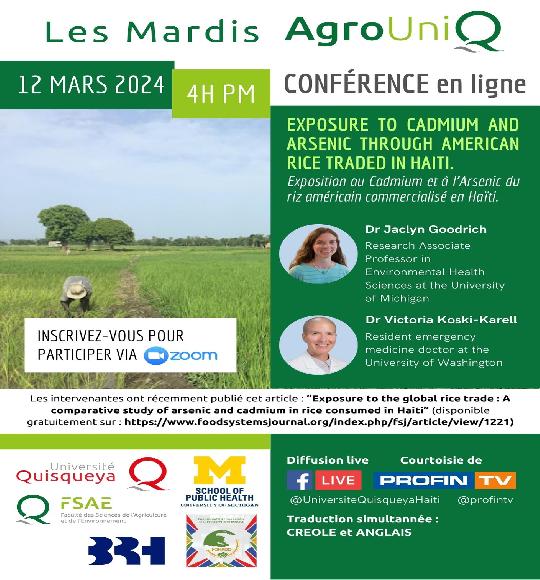Mardi AgroUniQ sur le thème : Exposition au Cadmium et à l'Arsenic du riz américain commercialisé en Haïti.
Intervenantes/Speakers :
 Dr Jaclyn Goodrich is Research Associate Professor in Environmental Health Sciences at the University of Michigan: Ann Arbor, MI, USA. She holds a doctorate in toxicology from the University of Michigan. She investigates the impact of environmental exposures including heavy metals and chemicals in plastics on human health. She conducts research on regional exposures of concern in the United States, Mexico, Haiti, and more with a particular focus on children’s and worker health.
Dr Jaclyn Goodrich is Research Associate Professor in Environmental Health Sciences at the University of Michigan: Ann Arbor, MI, USA. She holds a doctorate in toxicology from the University of Michigan. She investigates the impact of environmental exposures including heavy metals and chemicals in plastics on human health. She conducts research on regional exposures of concern in the United States, Mexico, Haiti, and more with a particular focus on children’s and worker health.
Goodrich’s personal webpage: https://sph.umich.edu/faculty-profiles/goodrich-jaclyn.html
 Dr Victoria Koski-Karell is a resident emergency medicine doctor at the University of Washington: Seattle, WA, USA. Dr. Koski-Karell holds MD and PhD degrees from the University of Michigan with specialization in sociocultural anthropology. Dr. Koski-Karell’s doctoral research was conducted in Haiti, and focused on cholera, water, and other issues faced in the Artibonite valley.
Dr Victoria Koski-Karell is a resident emergency medicine doctor at the University of Washington: Seattle, WA, USA. Dr. Koski-Karell holds MD and PhD degrees from the University of Michigan with specialization in sociocultural anthropology. Dr. Koski-Karell’s doctoral research was conducted in Haiti, and focused on cholera, water, and other issues faced in the Artibonite valley.
Résumé / Abstract:
Rice comprises nearly a quarter of dietary intake in Haiti. The trend in rice consumption began to rapidly increase during the mid-1980s and 1990s, corresponding to policy interventions promoting the importation and consumption of U.S.-grown rice that soon made Haiti the second largest export market for U.S. rice. Haitian growers also cultivate and sell local rice. Rice plants accumulate toxic metals, especially arsenic, from their environment, leading to a potential source of exposure for rice consumers. In August 2020, we collected 48 samples of local and 50 samples of imported rice from vendor sites in the Lower Artibonite Valley region. Cadmium and arsenic concentrations were measured and compared between local versus imported commercial rice samples. For arsenic, we conducted a simulation study to estimate the intake of arsenic from varied quantities of rice per day for adults and young children. On average, concentrations were nearly two-fold higher for both arsenic and cadmium in imported rice compared to local rice, though cadmium was very low in all samples. Our simulation of arsenic intake through rice consumption suggests that adults of varying weights consuming 3 or more cups of imported rice per day would exceed a daily minimum risk level for toxicity. The simulation also suggests that most young children consuming 1 or more cups of local or imported rice per day would exceed a health-based arsenic intake limit. Overall, imported rice had double the level of the toxic metal arsenic compared to locally grown product in the Lower Artibonite Valley. Reducing arsenic intake from imported rice, whenever possible, through optimal cooking procedures and through consuming a diverse diet of local product whenever possible are strategies that can reduce arsenic burden and improve health.
The authors recently published "Exposure to the global rice trade: A comparative study of arsenic and cadmium in rice consumed in Haiti" in Journal of Agriculture, Food Systems, and Community Development (see: https://www.foodsystemsjournal.org/index.php/fsj/article/view/1221)
Keywords: environmental health, metals, toxicology, public health, children’s health, sustainable agriculture, food systems, Haiti, rice production
Le riz représente près d'un quart de l'apport alimentaire en Haïti. La tendance de la consommation de riz a commencé à augmenter rapidement au milieu des années 1980 et 1990, correspondant aux interventions politiques promouvant l’importation et la consommation de riz cultivé aux États-Unis qui ont rapidement fait d’Haïti le deuxième marché d’exportation du riz américain. Les producteurs haïtiens cultivent et vendent également du riz local. Les plants de riz accumulent des métaux toxiques, en particulier de l'arsenic, provenant de leur environnement, ce qui constitue une source potentielle d'exposition pour les consommateurs de riz. En août 2020, nous avons collecté 48 échantillons de riz local et 50 échantillons de riz importé auprès des sites de vendeurs de la région de la Basse Vallée de l'Artibonite. Les concentrations de cadmium et d'arsenic ont été mesurées et comparées entre des échantillons de riz commercial local et importé. Pour l'arsenic, nous avons mené une étude de simulation pour estimer l'apport quotidien d'arsenic provenant de quantités variées de riz pour les adultes et les jeunes enfants. En moyenne, les concentrations d’arsenic et de cadmium dans le riz importé étaient presque deux fois plus élevées que dans le riz local, même si le cadmium était très faible dans tous les échantillons. Notre simulation de l'apport d'arsenic via la consommation de riz suggère que les adultes de poids variables consommant 3 tasses ou plus de riz importé par jour dépasseraient un niveau de risque quotidien minimum de toxicité. La simulation suggère également que la plupart des jeunes enfants consommant une ou plusieurs tasses de riz local ou importé par jour dépasseraient une limite d'apport en arsenic basée sur des critères de santé. Dans l’ensemble, le riz importé contenait le double du niveau d’arsenic métallique toxique par rapport aux produits cultivés localement dans la vallée inférieure de l’Artibonite. Réduire la consommation d'arsenic provenant du riz importé, autant que possible, grâce à des procédures de cuisson optimales et en consommant autant que possible une alimentation diversifiée à base de produits locaux sont des stratégies qui peuvent réduire la charge d'arsenic et améliorer la santé.
Les auteurs ont récemment publié "Exposition au commerce mondial du riz : Une étude comparative de l'arsenic et du cadmium dans le riz consommé en Haïti" dans le Journal of Agriculture, Food Systems, and Community Development (voir : https://www.foodsystemsjournal.org/index.php/fsj/article/view/1221)
Mots-clés : santé environnementale, métaux, toxicologie, santé publique, santé des enfants, agriculture durable, systèmes alimentaires, Haïti, production de riz
Participer au webinaire
Pour suivre la conférence, veuillez vous inscrire en cliquant sur le lien suivant :
https://us06web.zoom.us/webinar/register/WN_KWP1E-LiQC-0NyUCiwckAw
Après votre inscription, vous recevrez un e-mail de confirmation contenant les instructions pour rejoindre la conférence.
Partenaires




